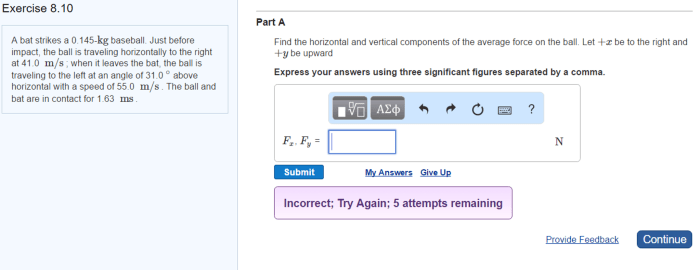When a bat strikes a 0.145 kg baseball, a fascinating interplay of physics unfolds. This collision, governed by the principles of conservation of momentum and energy, sets in motion a sequence of events that determine the ball’s trajectory, the bat’s response, and the outcome of the hit.
As the bat makes contact with the ball, a surge of force is generated, propelling the ball forward. The ball’s initial velocity, trajectory, and spin are influenced by the impact location, the bat’s speed and swing path, and the material properties of both the bat and the ball.
Ball-Bat Collision Mechanics

The collision between a baseball and a bat is a complex interaction that involves the conservation of momentum and energy. When the bat strikes the ball, the momentum of the ball is transferred to the bat, causing it to recoil.
At the same time, the energy of the ball is transferred to the bat, causing it to vibrate.
The impact force between the ball and the bat is determined by the mass of the ball, the velocity of the ball, and the coefficient of restitution between the two objects. The coefficient of restitution is a measure of how elastic the collision is, with a value of 1 indicating a perfectly elastic collision and a value of 0 indicating a perfectly inelastic collision.
Ball Trajectory
The trajectory of the ball after the collision is determined by its initial velocity and the angle of impact. The initial velocity of the ball is determined by the velocity of the bat and the coefficient of restitution. The angle of impact is determined by the angle at which the bat strikes the ball.
The trajectory of the ball can be calculated using the following equation:
“`y = x tan(θ)
(g x^2) / (2v^2 cos^2(θ))
“`
where:
- y is the height of the ball at a given distance x from the point of impact
- θ is the angle of impact
- g is the acceleration due to gravity
- v is the initial velocity of the ball
Bat Response
The bat responds to the impact of the ball by vibrating and recoiling. The vibration of the bat is caused by the transfer of energy from the ball to the bat. The recoil of the bat is caused by the transfer of momentum from the ball to the bat.
The magnitude of the bat’s vibration and recoil is determined by the mass of the bat, the stiffness of the bat, and the coefficient of restitution between the ball and the bat.
Material Properties
The material properties of the bat and the ball play an important role in the collision. The mass of the bat affects the bat’s recoil, while the stiffness of the bat affects the bat’s vibration. The coefficient of restitution between the ball and the bat is determined by the materials of the two objects.
The material properties of the bat and the ball can be used to optimize the performance of the bat. For example, a bat made of a stiffer material will vibrate less and transfer more energy to the ball, resulting in a higher ball velocity.
Impact Location
The impact location on the bat affects the trajectory of the ball. The impact location is determined by the point of contact between the ball and the bat. The point of contact is determined by the swing path of the bat and the angle of impact.
The impact location on the bat can be used to control the trajectory of the ball. For example, a batter can hit the ball on the sweet spot of the bat to maximize the ball velocity and launch angle.
Hitting Technique, A bat strikes a 0.145 kg baseball
The hitting technique of the batter plays an important role in the outcome of the collision. The hitting technique includes the bat speed, the swing path, and the contact point.
The bat speed is the speed of the bat at the moment of impact. The swing path is the path of the bat through the hitting zone. The contact point is the point at which the ball and the bat make contact.
The hitting technique can be used to optimize the performance of the batter. For example, a batter can increase the bat speed by swinging the bat faster. A batter can improve the swing path by keeping the bat on a level plane through the hitting zone.
A batter can improve the contact point by making contact with the ball on the sweet spot of the bat.
Data Analysis
Data analysis can be used to study the relationship between the variables involved in the collision. The variables involved in the collision include the ball velocity, the trajectory of the ball, and the impact location on the bat.
Data analysis can be used to optimize the performance of the bat and the batter. For example, data analysis can be used to determine the optimal bat speed, swing path, and contact point for a given batter.
Q&A: A Bat Strikes A 0.145 Kg Baseball
What factors influence the ball’s trajectory after being hit by a bat?
The ball’s trajectory is determined by its initial velocity, which is influenced by the impact location on the bat, the bat’s speed and swing path, and the material properties of the bat and ball.
How does the impact location on the bat affect the ball’s trajectory?
The impact location on the bat influences the ball’s spin, launch angle, and exit velocity. Different impact points result in different trajectories, such as line drives, ground balls, or fly balls.
What is the role of the bat’s material in the collision?
The bat’s material affects its stiffness, weight, and vibration characteristics. These properties influence the ball’s exit velocity, trajectory, and the recoil experienced by the batter.
